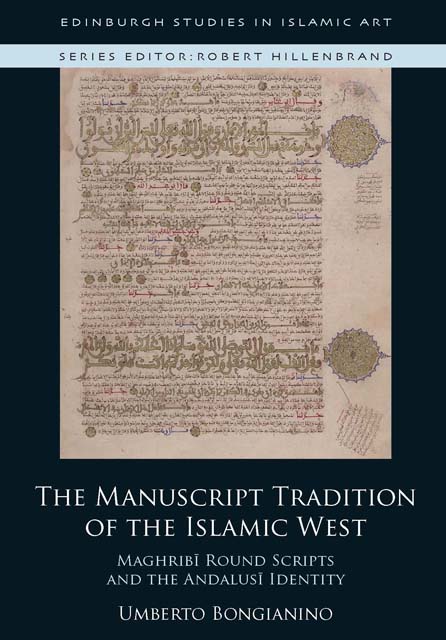Book contents
- Frontmatter
- Contents
- List of Figures
- Acknowledgements
- Note on Transliteration and Translation
- Abbreviations
- Series Editor’s Foreword
- Introduction: A Book about Books
- Chapter One Maghribī Round Scripts: A New Definition
- Chapter Two Maghribī Round Scripts in the Third/Ninth and Fourth/Tenth Centuries
- Chapter Three Maghribī Round Scripts in the Fifth/Eleventh Century
- Chapter Four Maghribī Round Scripts in the Sixth/Twelfth Century
- Chapter Five Beyond Books: Quranic Manuscripts and Chancery Documents
- Conclusion: Inscribed Identities
- I List of Dated Manuscripts
- II Titles and Genres of Dated Manuscripts
- III Copyists of Dated Manuscripts
- IV Places of Copying
- V Remarkable Colophons and Notes
- Glossary
- Bibliography
- Index
Introduction: A Book about Books
Published online by Cambridge University Press: 18 November 2022
- Frontmatter
- Contents
- List of Figures
- Acknowledgements
- Note on Transliteration and Translation
- Abbreviations
- Series Editor’s Foreword
- Introduction: A Book about Books
- Chapter One Maghribī Round Scripts: A New Definition
- Chapter Two Maghribī Round Scripts in the Third/Ninth and Fourth/Tenth Centuries
- Chapter Three Maghribī Round Scripts in the Fifth/Eleventh Century
- Chapter Four Maghribī Round Scripts in the Sixth/Twelfth Century
- Chapter Five Beyond Books: Quranic Manuscripts and Chancery Documents
- Conclusion: Inscribed Identities
- I List of Dated Manuscripts
- II Titles and Genres of Dated Manuscripts
- III Copyists of Dated Manuscripts
- IV Places of Copying
- V Remarkable Colophons and Notes
- Glossary
- Bibliography
- Index
Summary
THE DATE was Sunday, the 9th of Rajab 533, corresponding to 12 March 1139. Spring was about to begin in Almería, a thriving mercantile seaport and manufacturing city in what was then Almoravid Iberia. Those were the years of Almería's economic and cultural apogee, abruptly ended in 542/1147 with the sack and occupation of the city at the hands of Alfonso VII of León. The last chief judge of Almoravid Almería, Abd al-Ḥaqq Ibn ʿAṭiyya (481/1088–541/1147), had been appointed to this prestigious position a few years before, on account of his immaculate reputation: a learned and highly esteemed notable from nearby Granada, Ibn ʿAṭiyya was a distinguished scholar of Quranic exegesis, but also a grammarian and a poet. During his tenure, he promoted the heightening of the minaret attached to the congregational mosque of Almería, as well as the erection of a fountain for ritual ablutions: these works are attested by two commemorative inscriptions on white marble that have survived the destruction of the buildings they once adorned.
On the 9th of Rajab 533 a handsome manuscript was finally completed, containing a text that held great personal and sentimental value for Ibn ʿAṭiyya: his Fahrasa (‘Index’), a detailed record of his thirty teachers – starting from his own father – and of the religious and secular texts he had received and transmitted from them. In the medieval Islamic West it was not unusual for famed scholars who had reached a certain age to compile such bio-bibliographical works, which represented in many ways a summation of their knowledge and a testament to their scholarly achievements. What is extraordinary about Ibn ʿAṭiyya's Fahrasa, however, is that its original manuscript (Figure I.1) has miraculously survived in the Royal Library of San Lorenzo de El Escorial and can reveal so much more about the milieu in which it was written than any later copy.
Very much like Ibn ʿAṭiyya's Fahrasa, this is a book about books; and yet, the following pages will not be concerned with the lives and works of medieval Arabic authors and literati. What will be discussed instead is the activity of copyists and calligraphers – the individuals who physically transcribed the manuscripts owned and read by scholars such as Ibn ʿAṭiyya – through a comprehensive survey of what survives of their work.
- Type
- Chapter
- Information
- The Manuscript Tradition of the Islamic WestMaghribi Round Scripts and Andalusi Identity, pp. 1 - 12Publisher: Edinburgh University PressPrint publication year: 2022

